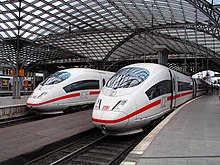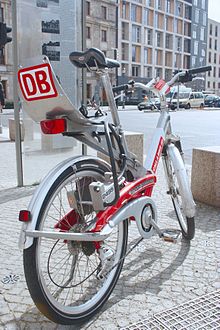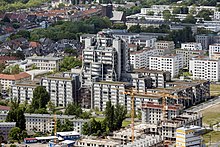DB Bahn
From December 2007 to the beginning of 2016, DB Bahn was one of three brands of Deutsche Bahn AG, alongside DB Schenker and DB Netze .
It included all DB mobility services and was dissolved in 2015 as part of a reorganization of the DB Group's brands.
Business areas
The passenger transport department has been divided into three business areas since 2010:
The DB Stadtverkehr (bus transport) business unit created in 2005 was reintegrated into the regional business unit.
In 2005 the railroad carried 118.7 million passengers over a total of 33,641 million kilometers in long-distance traffic. DB Fernverkehr AG provided the majority of this service with national and cross-border long-distance lines. The DB Autozug and Citynightline operated car and night trains .
In 2005, Deutsche Bahn transported more than 1.1 billion passengers in local transport, and 33,809 million passenger kilometers were covered. The passengers contributed to 32 percent of the turnover in the regional business unit, around 67 percent of the money came from the federal states, which are responsible for local transport under the regionalization law. The following subsidiaries of DB AG are active in this sector, classified according to turnover: DB Regio AG, DB ZugBus Regionalverkehr Alb-Bodensee GmbH and DB RegioNetz Verkehrs GmbH .
The former urban transport business unit was responsible for the S-Bahn in Berlin and Hamburg as well as for numerous bus companies, see DB Stadtverkehr . Together, the companies carried 524.4 million travelers over a total of 5,104 million kilometers in 2005.
As of January 1, 2011, the regional and urban transport business units were combined in the regional regional business unit. In the course of the Arriva takeover, Deutsche Bahn is concentrating national passenger transport at Regio and international passenger transport activities at DB Bahn Arriva.
Trains

The Intercity-Express is the flagship of the railway. The express train connects the larger cities with each other at speeds of up to 320 km / h. In 2006 it generated around 29 percent of the total volume of passenger traffic. The InterCity and the international Eurocity travel to the cities mostly every hour. Together, these types of trains provide around 14 percent of the transport performance. Another three percent is accounted for by additional long-distance transport products, such as car trains or night trains . Interregio-Express , Regional-Express , Regionalbahn and S-Bahn are the most important trains in local and urban transport, which have a transport performance share of 54 percent. Various planned routes of the Transrapid maglev , most recently the Transrapid Munich , failed due to a lack of economic efficiency. A new product will be available by 2030 with the Rhein-Ruhr-Express (RRX).
The 236 scheduled Intercity Express trains in four different variants are the most important part of the long-distance fleet. For regional and urban transport, the railway has almost 500 electric multiple units of the 481 series in the S-Bahn Berlin and again around twice as many trains in the similar series 420 , 422 , 423 , 424 , 425 and 426 , 430 , 440 and 442 , which operate as S-, regional trains and regional express. The most common is the 143 series with around 400 electric locomotives, which, however, are being displaced more and more by other series. In addition to these particularly frequent trains, the railway has numerous other series. The many diesel multiple units, such as the 628 series , which have partially replaced locomotive-hauled passenger trains away from the big cities, are remarkable . Since railcars are smaller and therefore more flexible to use than heavy trains with diesel locomotives, such a change took place between 1996 and 2005.
Customers and Service

DB Information ⊙
As a result of an empirical analysis, Jörg Nießing found that the price of the trip , convenience compared to the car and punctuality have a central influence on the loyalty of long-distance customers to the company. Jesko Perrey examined which customer groups the long-distance rail marketing should be aimed at. 51% of long-distance customers are price-sensitive, 31% are travel time minimizers and 18% are comfort-oriented.
Deutsche Bahn is less satisfied with its customers than any other industry, according to the results of the Customer Monitor Germany study presented in 2006. The Verkehrsclub Deutschland also sees many weaknesses. In a study, however, he shows that the railway is better than its reputation. Transport scientist and rail enthusiast Heiner Monheim also agrees , particularly praising the time that can be actively used on the train.
Fares
For travel, Deutsche Bahn offers two price models: the flex price, which applies to a certain route and basically allows you to choose your own train, and the saver price, which is set for the selected train. In addition, holders of a BahnCard can get discounts. There are also various other offers for families, passengers, groups, commuters and various special offers. However, different tariffs apply to local trains in transport associations .
The amount of the flex price depends on the connection, type of train and travel class. This enables the railway to adjust the prices to the competition on a route. If, for example, the train is relatively faster than the car, the fares are sometimes higher. With the contingent savings prices, Deutsche Bahn is trying to get more travelers onto the rails in times of low capacity utilization in the interests of yield management .
According to an investigation, the train prices are overestimated by those with no knowledge: travelers using various means of transport estimated the price of the Munich – Hamburg route at 140 percent of the actual price, and even more for shorter distances.
When advising in DB travel centers, a study by Stiftung Warentest showed that customers often did not get the cheapest offer. Too often expensive ICEs were preferred, even if cheaper ICs or regional trains hardly needed longer for the respective route. According to the 2010 test, rail passengers are best shown cheap connections on the DB website.
punctuality
The Stiftung Warentest evaluated the arrival times of 94,136 trains at their terminal stations in ten major cities between 6 a.m. and midnight between September 23 and October 31, 2007 (excluding strike days). According to this survey, of 23,261 long-distance trains, 46 percent were delayed by a maximum of one minute, 16 percent two to three minutes, ten percent four to five, 12 percent six to ten, eight percent eleven to 20, three percent 21 to 30 and four percent more than 30 Minutes late. Of the 70,875 regional trains examined, 56 percent were delayed at most one minute at the terminus, 20 percent were two to three minutes late, ten percent four to five minutes, nine percent six to ten minutes, four percent eleven to 20 minutes and one percent between 21 and 20 minutes 30 or more than 30 minutes delay. The Deutsche Bahn rejected the result of the survey and spoke of an overall punctuality in passenger traffic of “well over 90 percent” in 2007, without giving any more specific figures.
According to Deutsche Bahn, the punctuality between 1996 and 2003 was between 86.2 and 92.2 percent. The journalist Erich Preuss sees the most important causes of delays in outside influences and disobedient railway workers. Once a train is delayed, it is often difficult to get back on schedule due to insufficient capacity. To prevent delays from spreading across the entire network, Deutsche Bahn changed its waiting time rule in December 2003, according to which there is hardly any waiting for connecting trains. Punctuality improved, but travelers reach their connecting trains less often.
From 2008, Deutsche Bahn also changed its strategy to exhaust the network for fast connections as much as possible. Until then, the travel times became shorter and shorter. However, the optimization to speed meant that accumulating delays could no longer be absorbed. Especially in long-distance traffic, there were increasing delays. In the years that followed, the railway slowed down the connections in order to buffer the effects of the weather, construction work or other things, and to reduce delays. The scheduled travel time between Hamburg and Berlin, for example, was extended by six minutes between 2009 and 2012. The Ruhr area can also be reached from Northern Germany six minutes later.
Compensation for delays in passenger transport
On October 1, 2004, a new rule was introduced for compensation for delays in long-distance trains. In the case of train-related delays of 60 minutes or more, 20 percent of the fare for a single journey will be reimbursed as a voucher; in the ICE Sprinter from just 30 minutes. Owners of the BahnCard 100, an international ticket and a season ticket receive a flat rate compensation. From consumer associations are u. a. criticized these regulations, for example at ProBahn.
The German Bundestag has with validity from 29 July 2009, the traffic order Railway amended so that passengers get in the passenger is entitled to also use a higher-quality train at high delay their train (§ 17). However, the railway may refuse to do so in the case of "considerably reduced" tickets (Section 5). At the same time, the German Bundestag canceled the liability claim for delays in long-distance passenger transport that had been laid down in the ordinance.
Door-to-door mobility
In order to be able to offer travel chains from door to door, beyond the journey from station to station, further offers have been added to the product portfolio. These include a. the rental of bicycles ( Call a Bike ) and cars ( Flinkster ).
Seat
The Board of Management's Passenger Transport division has its headquarters together with DB Fernverkehr, DB Regio and DB Vertrieb at Stephensonstrasse 1 in the Gallus district of Frankfurt . This building, completed in 1993, served as the main administration of DB AG until 2000 .
Individual evidence
- ^ Deutsche Bahn with new brands . In: Frankfurter Allgemeine Zeitung . December 8, 2007. Accessed August 31, 2018.
- ↑ New name on Facebook and Google+ . In: DB Inside Bahn . February 3, 2016. Archived from the original on August 31, 2018. Info: The archive link was inserted automatically and has not yet been checked. Please check the original and archive link according to the instructions and then remove this notice. Accessed August 31, 2018.
- ↑ brand | DB marketing portal. Retrieved January 23, 2019 .
- ^ Business areas of DB Mobility Networks Logistics AG. 2011, accessed November 10, 2011 .
- ↑ a b c Deutsche Bahn AG: Key figures 2005 - DB AG with the best financial year in its history , 23 September 2006.
- ^ Deutsche Bahn AG: DB Fernverkehr AG . February 19, 2007.
- ↑ DB Regio AG: Annual Report 2005 ( Memento of the original dated September 30, 2007 in the Internet Archive ) Info: The archive link was inserted automatically and has not yet been checked. Please check the original and archive link according to the instructions and then remove this notice. (PDF; 1.9 MB). April 2006
- ↑ Deutsche Bahn AG: Annual Report 2005 ( Memento of the original dated September 30, 2007 in the Internet Archive ) Info: The archive link was inserted automatically and has not yet been checked. Please check the original and archive link according to the instructions and then remove this notice. (PDF; 10.3 MB). March 2006, p. 201.
- ↑ Deutsche Bahn AG: Annual Report 2005 ( Memento of the original dated September 30, 2007 in the Internet Archive ) Info: The archive link was inserted automatically and has not yet been checked. Please check the original and archive link according to the instructions and then remove this notice. (PDF; 10.3 MB). March 2006, p. 54
- ↑ DB press release, 074/2010.
- ↑ Deutsche Bahn AG: ICE and other long-distance trains - wherever you go - we have the right train for every route . September 23, 2006
- ↑ Deutsche Bahn AG: Taking bicycles with you in local transport ( Memento of the original from April 22, 2007 in the Internet Archive ) Info: The archive link was automatically inserted and not yet checked. Please check the original and archive link according to the instructions and then remove this notice. . Retrieved February 8, 2007
- ↑ Deutsche Bahn AG: Facts and Figures 2006 ( Memento of the original dated September 30, 2007 in the Internet Archive ) Info: The archive link was inserted automatically and has not yet been checked. Please check the original and archive link according to the instructions and then remove this notice. (PDF; 635 kB).
- ↑ Deutsche Bahn AG: Annual Report 2006 ( Memento of the original dated September 30, 2007 in the Internet Archive ) Info: The archive link was inserted automatically and has not yet been checked. Please check the original and archive link according to the instructions and then remove this notice. (PDF; 9.8 MB). March 2007, p. 118
- ^ The diesel railcars of the DB AG - The generation change In: BAHN-EXTRA March / April 2006, ISBN 3-89724-183-8
- ↑ Jörg Nießing: customer loyalty in the transport services sector. Gabler, Wiesbaden 2006, ISBN 3-8349-0167-9 , p. 191.
- ↑ Jesko Perrey: Benefit-oriented market segmentation in the transport services sector. P. 100f. In: Traffic Service Marketing. Gabler, Wiesbaden 2000, ISBN 3-409-11555-2 .
- ↑ Tagesspiegel Online: Service in Germany is improving . Berlin, September 20, 2006
- ^ Verkehrsclub Deutschland (VCD) e. V .: 1. VCD Bahnkunden Barometer ( Memento of the original from September 27, 2007 in the Internet Archive ) Info: The archive link was inserted automatically and has not yet been checked. Please check the original and archive link according to the instructions and then remove this notice. (PDF; 1.6 MB). Bonn 2001
- ↑ Heiner Monheim and Klaus Nagorni (eds.): The future of the railway: Between proximity to the citizen and going public. Evangelical Academy Baden, Karlsruhe 2004, ISBN 3-89674-119-5 , p. 240
- ↑ Deutsche Bahn AG: The cheapest way to your destination - the normal and saver prices of the train . April 5, 2007
- ↑ DB Fernverkehr AG: Conditions of carriage of the Deutsche Bahn AG (complete edition) ( page no longer available , search in web archives ) Info: The link was automatically marked as defective. Please check the link according to the instructions and then remove this notice. . Valid from June 10, 2007, pp. 3, 6ff., 38ff.
- ↑ Helmut Schneider: Price management in the service sector - the new price system of DB AG. P. 272 In: List forum for economic and financial policy. Baden-Baden, Nomos-Verl.-Ges., ISSN 0342-2623 , Vol. 29.2003, 3, pp. 268-283
- ↑ Helmut Schneider: price assessment in the transport services sector. Pp. 123, 138f. In: Traffic Service Marketing. Gabler, Wiesbaden 2000, ISBN 3-409-11555-2
- ↑ Stiftung Warentest: Price advice from the railway in: test, issue 04/2010 (accessed online: January 2, 2013)
- ↑ Stiftung Warentest: How punctual do the trains really run? . In: test . No. 2, 2008, ISSN 0040-3946 , pp. 78-82.
- ^ Deutsche Bahn AG: Deutsche Bahn punctuality at a high level ( Memento from February 2, 2008 in the Internet Archive ). Press release from January 24, 2008
- ↑ Erich Preuss: Railway in transition. transpress, Stuttgart 2004, ISBN 3-613-71244-X , p. 44 ff.
- ^ [1] Die Zeit, December 19, 2012.
- ↑ Per Bahn : Delays and cancellations of Deutsche Bahn AG trains
- ↑ Change of the railway traffic regulations. (PDF; 251 kB) pp. 2–4 , accessed on June 30, 2009 .





